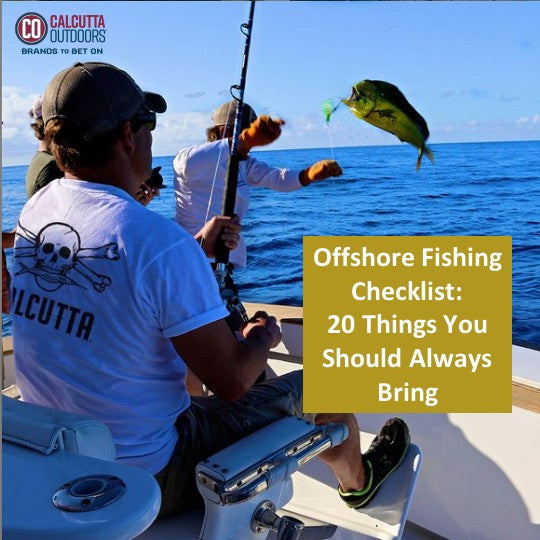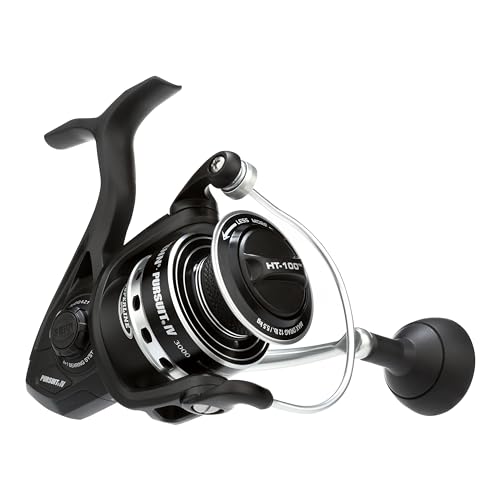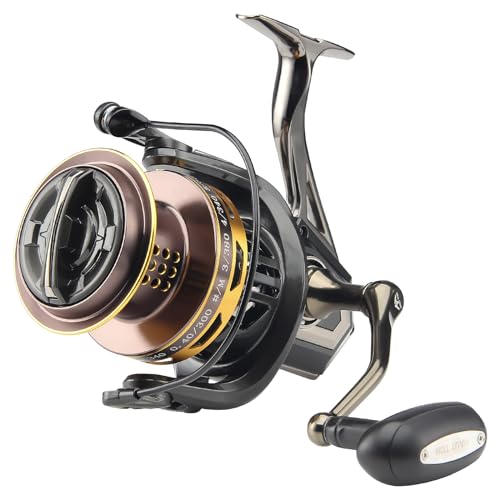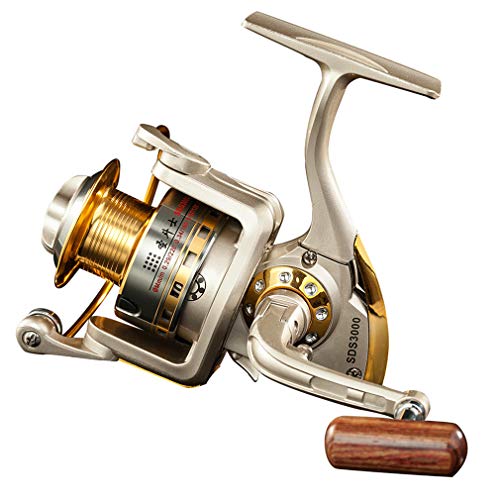For a deep sea fishing trip, wear comfortable clothes that can withstand water splashes and protect you from the sun, such as a hat, sunglasses, water-resistant shoes, and a lightweight, long-sleeved shirt. When heading out for a day of deep sea fishing, it’s important to dress accordingly to ensure both comfort and safety.
The open waters can be unpredictable, with strong winds, sea spray, and intense sun exposure. Therefore, it’s essential to wear the right clothing to protect yourself and maximize your enjoyment of the experience. We will guide you on what to wear on a deep sea fishing trip, providing valuable tips to keep you comfortable, safe, and ready for a day of adventure on the high seas.
Keep reading to find out the essentials of dressing for a successful deep sea fishing expedition.

Credit: www.calcuttaoutdoors.com
The Importance Of Proper Attire
Comfort And Functionality For A Successful Fishing Experience
Are you planning a deep-sea fishing trip? Choosing the right attire for your adventure is crucial. Not only does proper attire enhance your comfort and functionality, but it also ensures your safety while on the boat. In this section, we will discuss the importance of wearing the right clothes and gear for a successful deep-sea fishing experience.
Protecting Yourself From The Elements
When embarking on a deep-sea fishing trip, you must be prepared to tackle the elements. Here are some key points to consider when it comes to protecting yourself from the sun, wind, and water:
- Sun protection: The sun can be fierce out on the open water, so it’s essential to shield yourself from harmful uv rays. Wear a wide-brimmed hat, polarized sunglasses, and apply sunscreen with a high spf rating.
- Weatherproof clothing: Deep-sea fishing often involves being exposed to wind and water. Opt for lightweight, quick-drying clothing that provides protection against wind and splashes.
- Layering: Weather conditions can change rapidly at sea. Dress in layers, so you can add or remove clothing as needed to maintain a comfortable body temperature.
- Footwear: Choose appropriate footwear that provides grip and protection. Non-slip deck shoes or rubber-soled boots are ideal for traction on wet surfaces.
- Rain gear: In case of unexpected rain or spray, pack a waterproof jacket or poncho to keep yourself dry and comfortable.
Ensuring Safety While On The Boat
Safety should always be a top priority on a deep-sea fishing trip. Here are some essential points to consider when it comes to ensuring safety:
- Life jackets: Before setting sail, make sure there are sufficient life jackets available for everyone on board. Wear your life jacket at all times, especially if you are not a confident swimmer.
- Non-skid surfaces: Boat decks can get slippery, especially when wet. Wear shoes with non-skid soles to reduce the risk of accidents and falls.
- Hats and visors: Protecting your head from potential injury is vital. Wear a hat or visor that covers your head and shields your face from hooks and other equipment.
- Gloves: When handling fishing lines or other equipment, wearing gloves can provide extra grip and protection against cuts or abrasions.
- Emergency equipment: Familiarize yourself with the location and proper use of emergency equipment on board, such as fire extinguishers and first aid kits.
Remember, being properly attired not only enhances your overall fishing experience but also plays a significant role in your safety. So, be sure to dress for comfort, protect yourself from the elements, and prioritize safety while on the boat. Are you ready to make the most out of your deep-sea fishing adventure?
Essential Clothing For Deep Sea Fishing
When heading out on a deep sea fishing trip, it is crucial to wear the right clothing to ensure a comfortable and enjoyable experience. From protecting yourself from the sun’s rays to staying dry and cool, here are some essential items of clothing to consider:
Moisture-Wicking Shirts For Staying Dry And Cool
- Opt for moisture-wicking shirts that are specifically designed to draw sweat away from your body, keeping you dry and cool throughout the day.
- These shirts are typically made of lightweight and breathable materials such as polyester or nylon, allowing for better airflow and enhanced comfort.
- Look for shirts with upf (ultraviolet protection factor) ratings to provide additional sun protection for your skin.
- Long-sleeved moisture-wicking shirts can also offer protection from sunburn and potential abrasions.
Protective Sun Hats To Shield From Intense Sun Rays
- Invest in a wide-brimmed hat to shield your face, neck, and ears from the intense sun rays while out on the open water.
- Look for hats made from lightweight and breathable materials such as straw or fabric with upf protection.
- Hats with straps or chin cords are recommended to keep them secure in windy conditions.
- Consider hats with mesh panels for better ventilation and to prevent excessive sweating.
Polarized Sunglasses To Reduce Glare And Enhance Visibility
- Polarized sunglasses are a must-have for deep sea fishing to reduce glare reflecting off the water surface and improve visibility.
- Look for sunglasses specifically designed for water activities with polarized lenses.
- These sunglasses not only protect your eyes from harmful uva and uvb rays but also enhance the sharpness and clarity of your vision.
- Consider sunglasses with wraparound frames to provide maximum coverage and reduce light entering from side angles.
Lightweight And Quick-Drying Fishing Shorts
- Opt for lightweight and quick-drying fishing shorts made from materials such as nylon or polyester.
- These shorts are designed to dry quickly if you get wet and provide comfort during long hours on the boat.
- Look for shorts with multiple pockets to store essential items such as hooks, lures, or a small tackle box.
- Elastic waistbands or adjustable drawstrings ensure a secure and comfortable fit.
Sturdy And Non-Slip Footwear For Stability On The Boat
- Choose sturdy footwear with non-slip soles to provide stability and prevent accidents on the often wet and slippery surfaces of a fishing boat.
- Closed-toe shoes or sandals with secure straps are recommended to protect your feet and provide better support.
- Look for footwear made from durable materials that can withstand exposure to saltwater, such as rubber or synthetic materials.
- Consider shoes with drainage holes to allow water to escape and prevent the buildup of moisture.
Remember, comfort, protection, and functionality should be your top priorities when selecting clothing for a deep sea fishing trip. By wearing moisture-wicking shirts, protective sun hats, polarized sunglasses, lightweight fishing shorts, and sturdy non-slip footwear, you can fully enjoy your day on the water while staying safe and comfortable.
Must-Have Accessories And Gear
When preparing for a deep sea fishing trip, having the right accessories and gear can make a world of difference in your overall experience. Here are some must-have items to consider, ensuring that you’re well-equipped for a successful day out on the water:
- Waterproof and windproof jacket to shield from rain and wind: The weather conditions out at sea can be unpredictable, so it’s essential to have a reliable waterproof and windproof jacket. This will keep you protected from sudden rain showers and gusts of wind, allowing you to focus on enjoying your fishing adventure without getting soaked.
- Insulated jackets for colder fishing trips: If you plan on embarking on a deep sea fishing trip during colder seasons or in regions with chilly waters, an insulated jacket is a must. These jackets are designed to provide warmth and can keep you comfortable even in freezing temperatures. Layering your clothing with an insulated jacket will ensure you stay cozy throughout the day.
- Fishing gloves for grip and protection: The right pair of fishing gloves is crucial for both grip and protection. They offer better control when handling slippery fish, bait, or hooks, preventing accidental slips. Additionally, fishing gloves can protect your hands from the sun’s harmful rays, as well as any sharp objects you may encounter while on your fishing expedition.
- Sunscreen with high spf to safeguard against uv rays: Sun protection is essential during any outdoor activity, and deep sea fishing is no exception. The sun’s rays can be intense, especially when reflected off the water’s surface. Apply sunscreen with a high spf rating to protect your skin from harmful uv rays. Don’t forget to reapply regularly, especially if you’ll be spending long hours out on the boat.
- Wide-brimmed hats for added sun protection: Alongside sunscreen, wearing a wide-brimmed hat is a great way to shield your face, neck, and ears from the sun. Not only do hats provide additional protection from harmful uv rays, but they also help keep you cool by providing shade. Opt for hats with a breathable material that will keep you comfortable even in warm weather.
- Waterproof bags or containers for storing personal belongings: It’s essential to keep your personal belongings safe and dry during your fishing trip. Invest in waterproof bags or containers to store items such as your phone, wallet, and keys. This will ensure that even if accidental splashes or rain occur, your valuables will remain protected.
Properly equipping yourself with the right accessories and gear can significantly enhance your deep sea fishing experience. From waterproof jackets and insulated layers to fishing gloves and sun protection, these must-have items will keep you comfortable, safe, and ready to reel in the big catch.
So, make sure to pack these essentials before embarking on your next deep sea fishing adventure.
Choosing The Right Fishing Gear
Selecting A Suitable Fishing Rod And Reel For Deep Sea Fishing
When it comes to deep sea fishing, choosing the right fishing gear is essential for a successful and enjoyable experience. Here are some key points to consider when selecting a suitable fishing rod and reel:
- Determine the fishing technique: Different fishing techniques require different types of rods and reels. For deep sea fishing, the most commonly used techniques include trolling, bottom fishing, and jigging. Identify which technique you plan to use, as this will help guide your selection process.
- Consider the rod material and length: Deep sea fishing requires a sturdy and durable rod that can withstand the weight and power of large fish. Look for rods made from fiberglass or graphite, as these materials offer strength and flexibility. In terms of length, longer rods (around 7 to 10 feet) provide better casting distance and leverage when fighting against strong fish.
- Choose the appropriate reel type: There are two main types of reels used in deep sea fishing – spinning reels and baitcasting reels. Here’s a breakdown of each:
- Spinning reels: These reels are beginner-friendly and offer easy casting and line management. They work well for lighter baits and lures and are suitable for various fishing techniques. Spinning reels are also more forgiving when it comes to casting accuracy, making them a popular choice among beginners.
- Baitcasting reels: Baitcasting reels provide greater control and precision, making them ideal for experienced anglers. They allow for accurate lure placement and are more suitable for heavier lines and bigger fish. However, baitcasting reels require more practice and skill to master, as they can be prone to backlash and tangles.
- Consider the gear ratio: The gear ratio of a reel determines the speed at which the line is retrieved. For deep sea fishing, a high gear ratio (6:1 or higher) is recommended, as it allows for quick retrieves when dealing with fast-swimming fish or when reeling in a fish from deep water.
Understanding The Importance Of Line Strength And Length
The strength and length of the fishing line play a crucial role in deep sea fishing. Here’s why:
- Line strength: Deep sea fishing often involves battling powerful fish such as marlin, tuna, or swordfish. Using a line with sufficient strength is essential to withstand the force exerted by these fish and prevent it from snapping. Look for lines with a high pound test rating, typically ranging from 20 to 50 pounds or even higher, depending on the target species.
- Line length: When it comes to deep sea fishing, longer lines have several advantages. They allow for deeper drops when bottom fishing and provide more flexibility when trolling. Longer lines also give the angler more time to react and control the fish during a fight. Consider using lines that are at least 300 yards in length to ensure you have enough line to handle long runs by powerful fish.
Choosing Appropriate Bait And Lures For The Target Fish Species
Selecting the right bait and lures is crucial for enticing the target fish species during a deep sea fishing trip. Here are some key points to keep in mind:
- Research the target species: Before heading out on your deep sea fishing adventure, learn about the specific fish species you’re targeting. Understand their feeding habits, preferred prey, and the type of water environment they inhabit. This knowledge will help you choose the most suitable bait and lures.
- Live bait vs. Artificial lures: Deep sea fishing allows for a variety of bait and lure options. Live bait such as squid, mackerel, or sardines can be highly effective in attracting predatory fish. Alternatively, artificial lures such as jigs, poppers, or soft plastics can mimic the movement of baitfish and entice strikes. Experiment with different options to see what works best for your target species.
- Consider the depth and conditions: The depth at which you’ll be fishing and the prevailing conditions can also influence your bait and lure selection. For example, if you’re targeting fish near the surface, using topwater lures that create a commotion on the water’s surface can be effective. On the other hand, if you’re fishing at greater depths, using weighted jigs or deep-diving lures can help reach the fish you’re after.
Remember, deep sea fishing is not only about the gear you use but also the skills and knowledge you bring to the activity. Take the time to research and understand the unique challenges and techniques associated with deep sea fishing, and you’ll be well-prepared for an exciting adventure on the open waters.
Safety Measures To Consider
Deep sea fishing is an exhilarating activity that allows you to venture out into the open ocean and catch some impressive fish. However, it’s crucial to prioritize safety during your deep sea fishing trip to ensure a smooth and secure experience.
Here are some essential safety measures to consider:
Wearing A Life Jacket For Personal Safety
- A life jacket is a fundamental piece of safety equipment that can save your life in case of an emergency.
- Always wear a properly fitting life jacket that is approved by the relevant authorities.
- Make sure that everyone on board has a life jacket that is suitable for their weight and size.
- Check the condition of the life jackets before your trip to ensure they are in good working order.
- Remember that wearing a life jacket is not just about complying with regulations but is crucial for your personal safety.
Utilizing A Reliable And Properly Fitted Fishing Harness
- Fishing harnesses are important tools that provide stability and support when reeling in large, powerful fish.
- Ensure that your fishing harness is reliable and in good condition to avoid any accidents or injuries.
- Take the time to properly adjust and fit the harness to your body to maximize its effectiveness.
- Familiarize yourself with the proper usage and techniques for using a fishing harness to prevent strain and fatigue during your fishing adventure.
Familiarizing Yourself With Emergency Protocols And Procedures
- Before embarking on your deep sea fishing trip, familiarize yourself with the emergency protocols and procedures recommended by the charter operator or captain.
- Understand the location of emergency equipment, such as life rafts, flares, and fire extinguishers, on the boat.
- Know how to properly use the emergency equipment and ensure all passengers are aware of their locations as well.
- In the event of an emergency, remain calm and follow the instructions given by the captain or crew.
- Being prepared and knowledgeable about emergency protocols can make a significant difference in ensuring safety during your deep sea fishing trip.
Carrying A Fully Stocked First Aid Kit On Board
- It’s essential to have a well-stocked first aid kit on board in case of any injuries or medical emergencies.
- Ensure that your first aid kit includes essential items such as bandages, antiseptic wipes, adhesive tape, pain relievers, and any necessary prescription medications.
- Regularly check and replenish your first aid kit to ensure that all supplies are up to date and in good condition.
- Familiarize yourself with basic first aid procedures, such as treating minor cuts, burns, and bruising, before your trip.
- Having a fully stocked and well-maintained first aid kit on board can provide peace of mind and ensure that you can promptly address any injuries or medical issues that may arise.
By taking these important safety measures, you can ensure a safe and enjoyable deep sea fishing trip. Remember, safety should always be a priority, allowing you to relax and fully embrace the experience. So gear up and get ready for a thrilling adventure on the open seas!
Additional Tips And Recommendations
Dressing In Layers To Adapt To Changing Weather Conditions
When planning for a deep sea fishing trip, it’s crucial to dress appropriately for the ever-changing weather conditions you might encounter. Dressing in layers allows you to easily adjust your clothing based on the temperature and wind conditions throughout the day.
Here are some key points to keep in mind:
- Start with a moisture-wicking base layer to keep you dry and comfortable, especially if you anticipate sweating.
- Layer a lightweight long-sleeved shirt over the base layer for added protection against the sun’s rays and potential chilly winds.
- Consider wearing a lightweight jacket or fleece as an outer layer to provide warmth when needed.
- Don’t forget to bring a waterproof or windproof jacket in case of rain or strong winds.
- Opt for clothes made of quick-drying materials, as you may get wet from sea spray or sudden showers.
Checking The Weather Forecast Prior To Your Fishing Trip
To ensure a successful and enjoyable deep sea fishing trip, it’s essential to check the weather forecast beforehand. Here’s why:
- Knowing the weather conditions in advance helps you prepare accordingly, both in terms of clothing and equipment.
- Look for any indications of rough seas, storms, or high winds that may affect the overall experience and safety.
- Pay attention to the temperature range predicted for the day to determine what type of clothing layers you should pack.
- Keep an eye out for any weather advisories or warnings that could potentially lead to the cancellation or rescheduling of your trip.
Bringing Extra Clothing And Accessories In Case Of Unexpected Situations
When it comes to deep sea fishing, it’s always best to be prepared for any unforeseen circumstances. Here are some extra clothing and accessories you should bring along, just in case:
- Pack an extra set of dry clothes so you can change if you get wet during the trip.
- Bring along a hat or cap to shield your face from the sun’s rays and prevent sunburn.
- Don’t forget to pack a pair of sunglasses to protect your eyes from the glare of the water.
- Consider bringing a rain poncho or waterproof pants to keep you dry in case of unexpected rain or spray.
- Pack sunscreen with a high spf to protect your skin from the sun’s harmful uv rays.
Avoiding Brightly Colored Clothing That Might Scare Away Fish
While you may want to showcase your vibrant sense of style, it’s advisable to avoid wearing brightly colored clothing on your deep sea fishing trip. Here’s why:
- Bright colors can potentially scare away fish, making it more challenging to attract them to your bait.
- Fish are more sensitive to light and color contrasts, so wearing neutral or muted tones can help you blend in with the surroundings.
- Opt for clothing in shades of blue, green, or grey, as these colors mimic the natural environment of the water and are less likely to startle fish.
Packing Snacks, Water, And Hydration Packs For Sustenance Throughout The Trip
A deep sea fishing trip can be physically demanding, so it’s crucial to stay hydrated and energized throughout the day. Here’s what you should consider when packing snacks and beverages:
- Bring along a refillable water bottle to ensure you stay hydrated during the trip. Dehydration can be a real risk when spending hours under the sun.
- Pack a variety of snacks that provide sustained energy, such as trail mix, granola bars, or pieces of fruit. Avoid snacks that can easily spoil or melt.
- Consider bringing hydration packs or electrolyte drinks to replenish essential minerals lost through sweat.
- Keep in mind that space may be limited on the boat, so choose compact and non-perishable snack options.
Remember, proper planning and preparation are key to enjoying a successful deep sea fishing trip. By dressing in layers, checking the weather forecast, packing extra clothing and accessories, avoiding brightly colored clothing, and bringing snacks and water, you’ll be well-prepared for a memorable day on the water.
Final Thoughts
Ensuring A Memorable And Enjoyable Experience With The Right Attire
Planning a deep sea fishing trip? As you gear up for this exciting adventure, it’s crucial to make sure you have the right attire. Your clothing choices can greatly impact your overall experience, so it’s important to prioritize comfort, protection, and safety.
Here are some key points to consider:
- Wear appropriate layers: Check the weather forecast before your trip, and dress in layers accordingly. It can be chilly on the water, especially in the early morning or during windy conditions. Layering allows you to adjust your clothing to stay comfortable throughout the day.
- Choose moisture-wicking fabrics: Deep sea fishing can be physically demanding at times, and you may break a sweat reeling in a big catch. Opt for moisture-wicking fabrics like polyester or nylon that will keep you dry and comfortable, even if you get splashed by waves or experience light rain.
- Protect yourself from the sun: Spending hours under the sun can lead to sunburn and long-term damage to your skin. Ensure you wear a wide-brimmed hat, sunglasses with uv protection, and apply a broad-spectrum sunscreen with a high spf rating. Don’t forget to reapply sunscreen every few hours, especially after being in the water.
- Invest in non-slip footwear: The deck of a fishing boat can get wet and slippery, so it’s important to wear footwear that provides good traction. Opt for shoes with non-slip soles or deck shoes specifically designed for boating. Avoid flip flops or open-toed sandals, as they can be hazardous and provide minimal protection.
Prioritizing Comfort, Protection, And Safety During A Deep Sea Fishing Adventure
When embarking on a deep sea fishing trip, comfort, protection, and safety should be top priorities. Consider the following points to ensure you have an enjoyable and worry-free experience:
- Choose lightweight and breathable clothing: Opt for lightweight, breathable fabrics that allow for easy movement and provide ventilation. This will help you stay cool and comfortable throughout the day.
- Wear a sturdy life jacket: Even if you are a strong swimmer, wearing a life jacket is essential for your safety. Choose a well-fitting, coast guard-approved life jacket that is suitable for boating activities. Make sure it is properly fastened before you board the boat.
- Protect yourself from the elements: In addition to sunscreen and a hat, consider bringing a lightweight rain jacket or windbreaker in case the weather changes unexpectedly. It’s better to be prepared than caught off guard by a sudden downpour or gusty winds.
- Don’t forget about insect protection: Depending on your location and the time of year, you may encounter pesky insects like mosquitoes. Apply insect repellent to exposed skin to protect yourself from bites. Consider wearing long sleeves and pants to provide an extra layer of protection.
- Bring a change of clothes: Packing a change of clothes is a smart move, especially if you anticipate getting wet or sweaty during the trip. Having a fresh set of clothes can make you feel more comfortable and ready to relax after a long day of fishing.
Investing In High-Quality Gear That Will Enhance Your Overall Experience
When it comes to deep sea fishing, having the right gear can make a world of difference. Invest in high-quality equipment to enhance your overall experience and improve your chances of success:
- Choose a reliable fishing rod and reel: Look for a fishing rod and reel that are suitable for deep sea fishing. Consider the type of fish you’ll be targeting and choose a setup that matches the fishing conditions and your skill level. Quality equipment will be more durable and increase your likelihood of landing that trophy catch.
- Use sturdy fishing line: Deep sea fishing often involves battling strong fish that can put a lot of strain on your fishing line. Invest in a high-quality line with a high pound test rating to ensure it can withstand the rigors of deep sea fishing.
- Pack essential accessories: Don’t forget to bring a tackle box with a variety of hooks, sinkers, leaders, and other necessary fishing accessories. Additionally, consider bringing a fishfinder device to locate fish more easily and increase your chances of success.
- Stay organized with a fishing vest or tackle bag: Keep your gear accessible and organized by using a fishing vest or tackle bag. These are designed with multiple pockets and compartments to hold your essentials, making it convenient to find what you need quickly.
- Don’t skimp on safety equipment: Besides life jackets, ensure your deep sea fishing boat is equipped with essential safety gear such as a first aid kit, fire extinguisher, and emergency signaling devices. Your safety should never be compromised.
Remember, investing in high-quality gear not only enhances your overall experience but also ensures your safety and increases your chances of success on your deep sea fishing trip. So, pack your bags, outfit yourself in the right attire, and get ready for an unforgettable adventure on the open water!
Conclusion
To ensure a successful and comfortable deep sea fishing trip, it is crucial to consider your clothing choices. Opt for lightweight and breathable fabrics that will keep you cool in the sun and dry quickly if you get wet. Long-sleeved shirts and long pants will provide protection against the sun’s rays and pesky insects.
Don’t forget to bring a wide-brimmed hat and polarized sunglasses to shield your eyes from the glare of the water. When it comes to footwear, sturdy and non-slip shoes are essential to keep you safe on the slippery deck. Layering your clothing will help you regulate your body temperature throughout the day.
Lastly, always check the weather forecast before you head out and dress accordingly. By following these clothing tips, you’ll be able to fully enjoy your deep sea fishing adventure and create lasting memories with friends and family.





